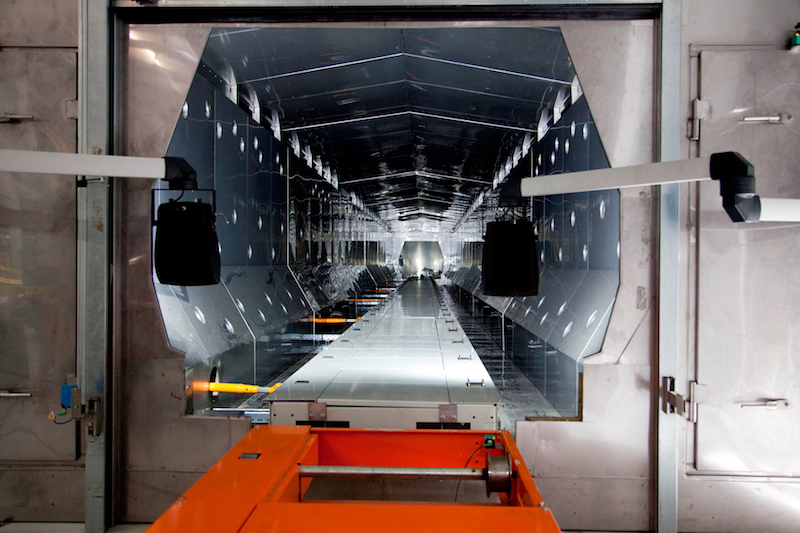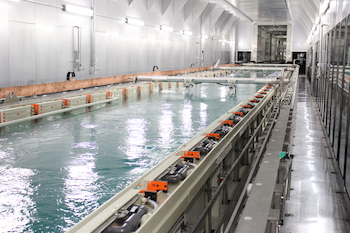As Audi prepares to become the first OEM to export high-end vehicles made in Mexico, AMS takes a look inside the new paintshop at the San José Chiapa plant, Puebla, before it comes on stream this September On September 30 this year, Audi will officially open its new plant at San José Chiapa on 400 hectares of land in Puebla State, Mexico, where it will make the new Q5 SUV for all global markets except China. The car will be unveiled on the same day at the Paris Motor Show. This will be an important moment, marking the first time that a premium maker exports cars made in Mexico. It also adds the Q5 to the very small number of premium vehicles built ground-up in an emerging economy for global consumption. So there is a lot at stake for Audi. Most importantly, the carmaker must ensure that it can achieve the same quality in Mexico as in Europe, including the body protection and finish in the plant’s paintshop.
On September 30 this year, Audi will officially open its new plant at San José Chiapa on 400 hectares of land in Puebla State, Mexico, where it will make the new Q5 SUV for all global markets except China. The car will be unveiled on the same day at the Paris Motor Show. This will be an important moment, marking the first time that a premium maker exports cars made in Mexico. It also adds the Q5 to the very small number of premium vehicles built ground-up in an emerging economy for global consumption. So there is a lot at stake for Audi. Most importantly, the carmaker must ensure that it can achieve the same quality in Mexico as in Europe, including the body protection and finish in the plant’s paintshop.
Carsten Mohr, manager of the new paintshop, says that training is the key to make sure that a German customer will not notice any drop-off in paint quality compared with, for example, an A4 made at Ingolstadt in Germany (also where the outgoing Q5 is made). “About 100 of our specialists were trained intensively over the past years in our paintshops in Ingolstadt and Neckarsulm [Germany],” he comments. Other employees who were not sent to Audi’s homeland will receive “several weeks” of training, Mohr says.
The paintshop will eventually employ 600 workers when the plant’s 150,000-unit annual capacity is reached, out of a total of 4,200 employees targeted by the end of the year. At the end of 2015, it was already employing 2,038.
As for the technology involved, Audi does not need to worry too much here with regard to quality. San José Chiapa will use the Eco+Paintshop system developed by German paint specialist Dürr, which has been successfully installed in many factories around the world.

Audi claims that its new facility will be “the most environmentally friendly paintshop on the American continent”, though without specifying which facility it considers to be the current top performer. However, given that the Volkswagen (VW) plant at Chattanooga, Tennessee, built in 2010, was fitted with perhaps the most environmentally crucial piece of technology, Dürr’s EcoDrySrubber paint overspray separator, it can be inferred that this is the benchmark to beat. In a statement, Dürr said that San José Chiapa will be “one of the world’s most environmentally friendly paintshops”.
Depending on Dürr technologyThe Dürr technology used at San José Chiapa, and elsewhere by Audi and other OEMs, includes EcoDryScrubber. This sits below the spray cabins and removes the 15% or so overspray from the air by using a limestone powder, which can later be reused by the cement industry, according to Mohr. Dürr says this method makes a big difference to efficiency; in conventional systems, the overspray paint particles are captured and extracted using chemically impregnated water, which requires expensive treatment to prevent wastewater contamination. In the old-style system, the paint sludge also has to be removed and the air dehumidified before reuse. Recirculation of that air (so as not to rely on filtered air from outside) requires rehumidification. All of this uses significant amounts of energy.
Mohr says that EcoDryScrubber will cut water consumption by 60% and energy use by up to 50%. Reusing the air will save 80% on systems which filter fresh air from outside. This means that Mexico’s hot climate will not impact on the painting process. “The system of recirculating air makes us completely independent of the outside climate situations,” confirms Mohr.
“We built on a greenfield [site], so we organised the processes in the [paint]shop very smartly and efficiently” – Carsten Mohr, Audi
EcoDryScrubber technology was previously installed at Audi’s plant in Győr, Hungary. Dürr reckoned back in 2011, when it announced the contract to build Audi’s paintshop there, that the business was worth €60m ($66.6m). Audi has given no figure for the cost of the paintshop at its new Mexican plant, which represents a total investment of $1 billion.
One other significant advantage of EcoDryScrubber is that it takes up a smaller space compared with water-based systems, thanks in part to the absence of a large air extraction and intake system. The paintshop in Mexico covers 65,000 sq.m but is arranged over four floors. “It’s very compact. We built on a greenfield [site], so we organised the processes in the shop very smartly and efficiently,” explains Mohr. The 600 or so employees will all work on the ground floor, while the automated processes take place above.
Audi figured out how the plant would all fit together by using virtual simulation, an innovation that Mohr said has made a significant contribution. “We were able to reduce the ground space. But the biggest advantage has been avoiding [the] interference of equipment and installations,” he says. “Therefore, we never had any problems with ventilation systems, our painting robots and installation.”
Installing RoDip and robotsAnother Dürr technology being installed at San José Chiapa is Ecopaint RoDip, a system which flips the bodies during pretreatment and the cathodic electrocoating bath that prepares the car bodies for primer and topcoat painting. Dürr says this system is a big improvement over the traditional dipping method, which runs the cars down a ramp, through the bath, and then back up. The end-over-end flip eliminates the need for two ramps, reducing the volume of the dip bath – meaning less water, fewer chemicals and lower power. This also cuts down the space needed to install it.
Dürr claims that the system improves the quality of surface coating and de-greasing, which creates the cleaner surface needed for new paint technologies. The company reckons the process removes almost all contaminant particles and completely floods out the cavities. The other selling point Dürr highlights is the overall cost saving. It reckons the technology saves 16% per car of the total paint cost compared with a conventional system (based on a European factory making 300,000 midsize cars a year). Indeed, RoDip has already been implemented successfully in Europe – the oldest electrically driven RoDip plant being Maranello, Italy, where it has been used to dip Ferrari bodies since 2004. In 2014, Dürr estimated that, in the previous five years, 30m cars were dipped using this method.
 Dürr is supplying the equipment for Audi's Mexican paintshop, including its Ecopaint RoDip system (above)
Dürr is supplying the equipment for Audi's Mexican paintshop, including its Ecopaint RoDip system (above)The San José Chiapa paintshop will use 36 Dürr EcoRP L133 robots with EcoBell3 rotary atomisers which provide ten-second colour changes for basecoats, with paint loss that Dürr estimates to be only about 10-15ml per change. The interior of the car will be painted as well as the exterior; 24 robots have been installed to open the doors and bonnet for this purpose.
In addition to the paint robots, the plant will use ten Dürr EcoRS16 robots for underbody and seam sealing. Mohr says the automation level in the paintshop will be 60%. The total time each body spends in the paintshop will be ten hours.
The Dürr robots are tried-and-tested technology; the company started developing its own painting robots in the mid-1990s and first installed them at Nissan Barcelona, Spain, in 1998. In March this year, Dürr announced that it had delivered its 10,000th RP painting robot.
Growing premium production in MexicoAudi will not say which paint supplier it will use at San José Chiapa, but it has worked with BASF Coatings in the past. The vehicle-maker is also likely to link up with suppliers to VW’s vast and long-established manufacturing complex in Puebla City, just 40 miles west of San José Chiapa.
Audi will not be the only premium OEM manufacturing in Mexico for long. BMW is building a plant in the north-central state of San Luis Potosí which is due to be completed by 2019, when it will start making the new 3-Series. BMW says that this factory will be fully powered by green energy, and that its paintshop will feature state-of-the-art technology to enhance efficiency and sustainability; it will be the first in the OEM’s global production network to produce zero process wastewater. Mercedes, too, is working on the development of a plant with its partner Nissan at Aguascalientes to make smaller Mercedes and Infiniti cars from 2017, so it seems there could be more than one challenger for the title of “most environmentally friendly paintshop” which Audi is claiming for San José Chiapa.
No doubt representatives from both of Audi’s German rivals will be inspecting the quality of the new Q5 at this autumn’s Paris Motor Show. Judging by all the planning, time and money Audi has invested in its new San José Chiapa facility, it seems likely the finish will be up to scratch.
































